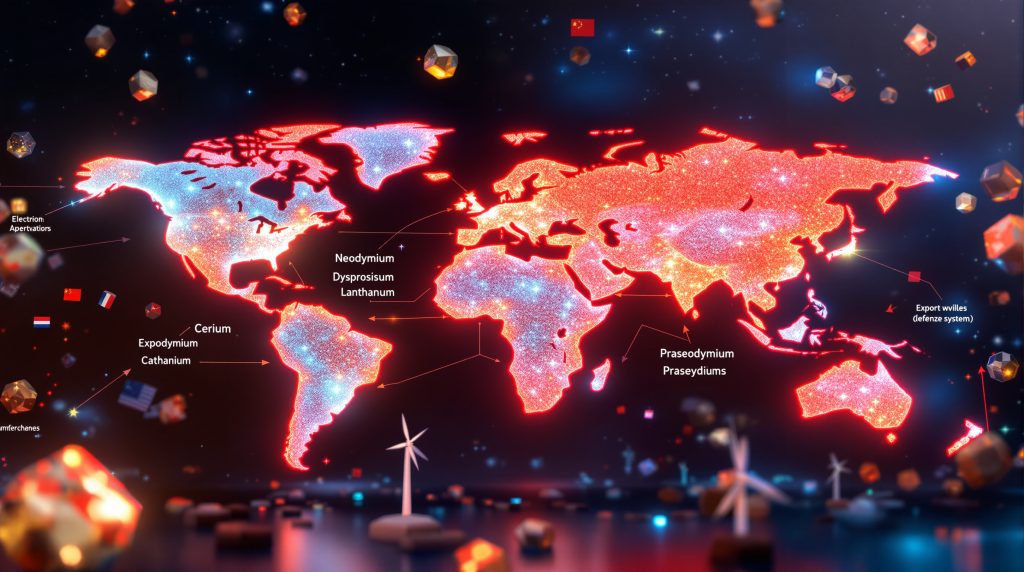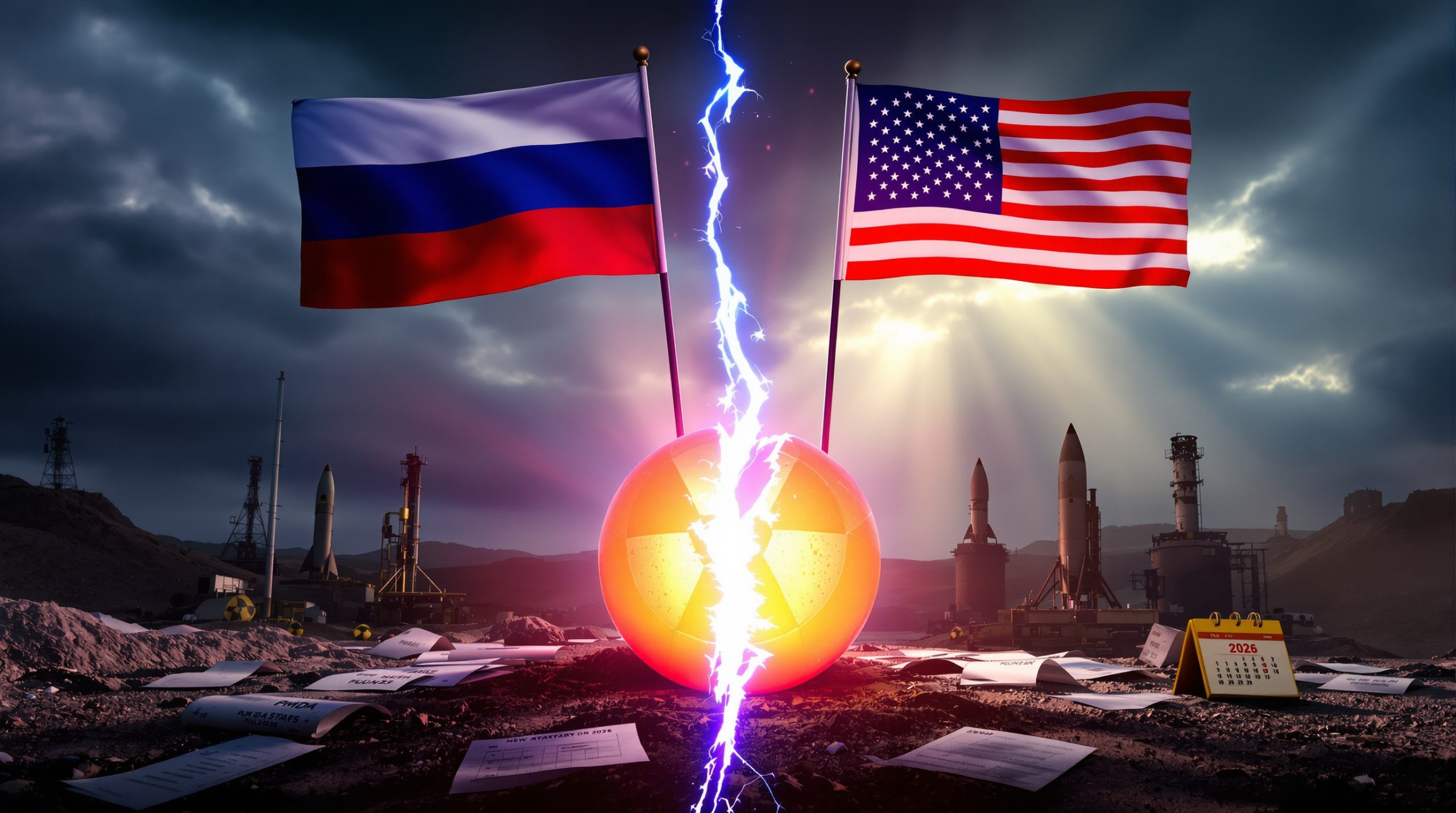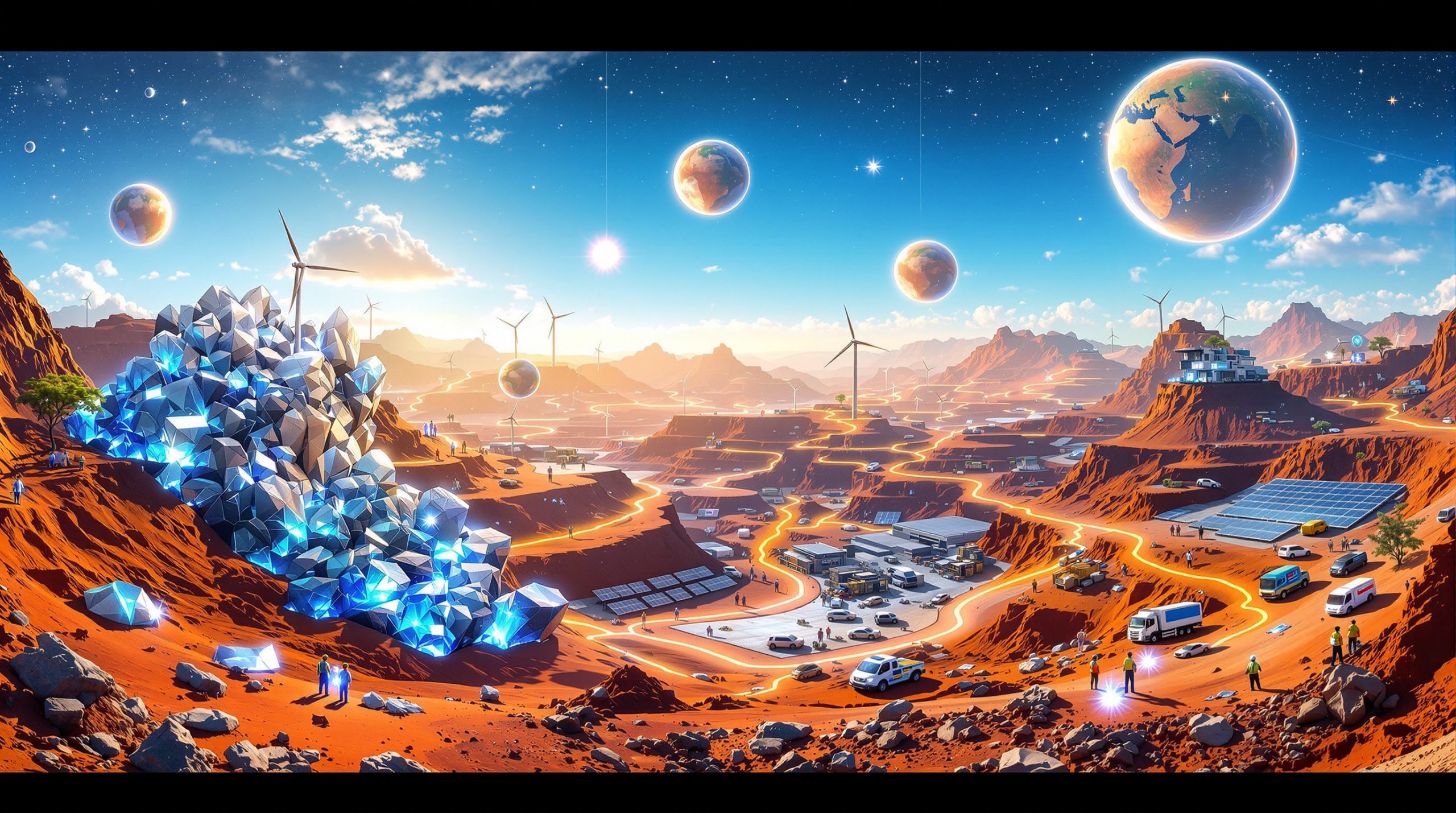What Are Rare Earth Elements and Why Do They Matter?
Rare earth elements (REEs) are a group of 17 metallic elements critical to modern technology, national defense, and the green energy transition. While their name suggests scarcity, these elements are relatively abundant in the Earth's crust. However, what makes rare earths strategically important is the technical difficulty and economic cost of extracting and processing them into usable forms.
Key areas where rare earths drive innovation and security include:
- Defense systems such as precision-guided munitions, military communication equipment, and stealth technologies
- Electric vehicles (EVs) and renewable energy infrastructure, especially wind turbines and advanced batteries
- High-tech electronics including smartphones, computers, and medical devices
- Industrial catalysts and specialized optical applications
Production and supply of rare earths are heavily concentrated, presenting significant supply-chain risk for consuming countries. Over 90% of processed rare earths and rare earth magnets globally originate from China (Reuters, October 9, 2025). The United States, in contrast, has just one major operating rare earth mine.
Key Rare Earth Elements and Their Applications
| Element | Critical Applications | Strategic Importance |
|---|---|---|
| Neodymium | Permanent magnets, electric motors | Essential for EVs and wind turbine production |
| Dysprosium | High-temp magnets, nuclear reactors | Ensures performance in defense/aerospace electronics |
| Lanthanum | Catalytic converters, battery electrodes | Vital for hybrid vehicles and petroleum refining |
| Cerium | Polishing powders, catalysts | Used in automotive catalytic converters |
| Praseodymium | Magnets, specialized glass | Enhances strength of magnets for motors/actuators |
Geologically, rare earths are found in several types of deposits; yet, mineral grades differ and only a small portion of resources are economically viable. Processing requires precise separation techniques tailored to closely related chemical properties, posing additional barriers to rapid scaling outside established hubs.
How Have Global Export Controls Evolved?
Over the past two decades, the global approach to rare earths export controls has shifted markedly. Once characterized by relatively open markets, the sector has moved toward heightened strategic resource nationalism.
- In recent years, export policies have grown more security-focused as rare earths are recognized as potential geopolitical leverage.
- April 2025 saw sweeping Chinese export controls that caused immediate shortages worldwide, especially in markets dependent on rare earth components (Reuters, October 9, 2025).
- The October 2025 tightening further expanded these controls, including new restrictions on technology transfer, equipment exports, and technical expertise.
- Increasingly, controls now target both military and commercial applications, such as semiconductors and advanced electronics.
| Year | Policy Milestone | Notable Impact |
|---|---|---|
| 2010–2012 | Early Chinese export quota restrictions | Led to WTO disputes, exposed vulnerabilities |
| 2023 | U.S./EU critical minerals initiatives | Sought diversified, secure REEs supply |
| 2025 | Expanded Chinese export controls | Sparked global shortages, amplified urgency |
Export controls have become more granular, with technology and intellectual property restrictions preventing key processing knowledge from leaving dominant supply countries.
What Prompted China's Tightening of Rare Earth Export Controls?
The latest round of Chinese rare earths export controls reflects a combination of economic strategy and geopolitical maneuvering.
- The moves came on the heels of U.S. lawmakers calling for wider bans on chipmaking equipment exports to China, signaling a tit-for-tat approach in critical technology disputes.
- Announced just ahead of scheduled international trade discussions, these controls offer China added leverage.
- With over 90% global processing capacity, China seeks to protect its market dominance and stifle outside efforts to compete in value-added manufacturing.
Strategically, China's policy aims to maintain control over the supply chain from resource extraction to advanced materials, pressuring nations reliant on imports to accelerate domestic capabilities. This approach aligns with their broader critical minerals pivot strategy to maintain market dominance.
How Has the Market Responded to Export Control Announcements?
The financial markets' response to rare earths export controls has been both swift and significant, especially for non-Chinese mining companies and critical minerals ETFs.
Key market movements following the October 2025 announcement:
- Critical Metals: Stock surged nearly 18% to $13.86
- Ramaco Resources: Rose 11%
- NioCorp Developments: Increased by 5.5%
- Trilogy Metals, MP Materials, USA Rare Earth: Each rose over 4%
- VanEck Rare Earth and Strategic Metals ETF: Gained 1% in a day, up 91% year-to-date
This demonstrates how export controls fuel demand for rare earth projects outside China. Investors are actively reallocating capital toward companies with potential to plug supply gaps or expand local processing capabilities.
Such investor enthusiasm reflects expectations that new policies may lead to:
- Price volatility across rare earth oxides and downstream products
- Reshuffling of long-term supply contracts
- Inventory build-up by manufacturers seeking to hedge future risk
What Is the Current Global Rare Earth Supply Landscape?
The rare earths sector is defined by a stark imbalance between mining and processing locations. While mining has become moderately diversified, processing remains overwhelmingly concentrated.
According to the U.S. Geological Survey (USGS) 2024:
- Total global mine production (2023): ~350,000 metric tons (REO basis)
- China: 240,000 metric tons (~70% of world total)
- United States: 43,000 metric tons (all from the Mountain Pass mine in California)
- Myanmar: 38,000 metric tons
- Australia: 22,000 metric tons
However, China processes over 90% of the world's rare earth concentrates into usable magnetic and high-purity forms, representing a critical bottleneck. Even if alternative mining projects accelerate, it will take years for non-Chinese refineries to reach scale.
| Country | 2023 Mine Production (tonnes REO) | % Global Processing Share |
|---|---|---|
| China | 240,000 | >90% |
| U.S. | 43,000 | Minor |
| Myanmar | 38,000 | Minor |
| Australia | 22,000 | Minor |
How Are Countries Responding to Supply Chain Vulnerabilities?
Faced with supply security threats, major economies have adopted multifaceted strategies to reduce rare earth dependency:
- Government initiatives: The U.S. government has boosted investment in rare earth miners and processors via the Defense Production Act and strategic sector funding (Reuters, October 9, 2025). Similar programs are in place across the EU and Japan.
- Streamlined regulations: Permitting processes for strategic mineral projects in North America and Australia have been expedited, aiming to remove bureaucratic barriers.
- International collaborations: Cross-border agreements—such as between the U.S. and Australia, and U.S.-Canada partnerships—are advancing alternative processing and separation technologies.
- Industry partnerships: Public-private consortia have formed to pursue complete value chains from resource extraction to finished magnets, emphasizing knowledge-sharing and R&D.
These efforts include mapping new deposit discoveries, supporting downstream innovation, and fostering recycling capabilities. Furthermore, there has been increased focus on establishing Australia's strategic reserve to ensure supply chain resilience.
What Are the Technical Challenges in Establishing Independent Supply Chains?
Transitioning from resource discovery to full-fledged mine-to-magnet supply chains outside China is a complex, multi-stage process.
Key technical and operational hurdles include:
- Extraction: Rare earth ores are often of lower grades and require sophisticated mining methods, raising both costs and technical barriers.
- Separation: State-of-the-art chemical processing and solvent extraction are necessary to isolate individual REEs. Proprietary knowledge and specialized equipment are in short supply outside China.
- Environmental management: Rare earth mining and processing generate significant waste and, in some cases, radioactive byproducts; environmental compliance is both demanding and costly.
- Expertise: Scarcity of experienced chemical engineers and metallurgists familiar with complex separation and refining technologies beyond China.
- Capital intensity: High upfront investment—with facility construction, workforce training, and regulatory approval easily taking 5–10 years for a competitive operation.
Supply chain security cannot be realized through mining alone. Vertical integration and local ecosystem building are essential, as highlighted by industry analysts during recent market developments (Reuters, October 9, 2025). The implementation of new mining industry innovation trends will be crucial for overcoming these challenges.
How Might Export Controls Impact Different Industries?
Export controls on rare earths reverberate across several critical industries, most notably:
- Defense sector: Modern military systems rely on rare earths for high-strength magnets in guidance systems, communication devices, and radar modules. Restrictions could constrain operational readiness and prompt urgent stockpiling.
- Electric vehicle manufacturing: Permanent magnet motors used in EVs require neodymium, praseodymium, and dysprosium. Any disruption threatens battery and motor supply chains, potentially delaying electrification targets.
- Renewable energy deployment: Wind turbines and high-efficiency generators depend on REEs for key components. Shortages may delay projects and increase reliance on fossil fuels.
- Consumer and medical electronics: Smartphones, medical imaging devices, and other electronics use rare earths in miniaturized components, making them vulnerable to price shocks and supply interruptions.
- Semiconductor industry: Some rare earths are crucial to chip fabrication; controls targeting equipment and materials further escalate supply risks.
Price volatility and supply unpredictability can translate into cost increases for finished goods and slower technology adoption rates in the medium term. This has prompted renewed interest in critical minerals energy security initiatives across developed economies.
What Opportunities Exist for Non-Chinese Producers?
The tightening of rare earths export controls has unlocked a historic window for non-Chinese companies to capture market share and investment. Key drivers for this opportunity include:
- Surge in share prices and valuation for Western rare earth mining and processing companies:
- Critical Metals (+18% in a single day)
- Ramaco Resources (+11%)
- NioCorp Developments (+5.5%)
- MP Materials and USA Rare Earth (both over +4%) (Reuters, October 9, 2025)
- VanEck Rare Earth and Strategic Metals ETF up 91% year-to-date, indicating robust investor appetite.
- Increased government support and incentives for 'mine-to-magnet' integration.
- Stronger collaboration and technology transfer agreements between allied countries.
Considerations for Success:
- Gaining acceptance from OEMs and downstream manufacturers
- Rapid development of separation, refining, and alloying capabilities
- Innovative recycling methods to recover REEs from scrap and end-of-life products
- R&D into alternative materials to reduce reliance on the most strategically vulnerable elements
While the market is primed for new entrants, the technical and financial barriers for scaling operations remain substantial, calling for integrated, multi-year planning and sophisticated project execution.
What Are the Long-Term Implications of Rare Earth Export Controls?
The long-term trajectory of the rare earths sector post-export controls will likely reshape global industrial and trade dynamics. Several trends are emerging:
- Supply chain diversification: Manufacturers are adopting multi-sourcing strategies and building regional production hubs closer to end-users.
- Vertical integration and localization: Companies are investing in end-to-end rare earth supply chains, from mining through magnet production, to secure critical inputs.
- Technological innovation: More R&D is now focused on substitution, recycling, and minimizing rare earth content in products.
- Resource diplomacy: Critical minerals will increasingly become focal points in international agreements and trade negotiations.
The overarching message from recent policy shifts is clear: long-term supply chain security requires new investment in independent value chains and rapid technological adaptation (Reuters, October 9, 2025). Additionally, Trump's critical minerals order has accelerated American interest in securing domestic supply chains.
Disclaimer:
Forward-looking statements in this article, such as supply chain diversification timelines, technology development, trade re-alignment, or future market performance, involve assumptions and uncertainty. Actual events could differ due to policy changes, market dynamics, or technological breakthroughs.
FAQ: Rare Earth Export Controls
What exactly are rare earth elements?
Rare earth elements are a set of 17 chemically similar metals that, while present throughout the Earth's crust, are rarely found in concentrations that make economic extraction straightforward. Their "rarity" is due more to complex processing needs than physical scarcity.
Why are rare earths strategically important?
Their unique magnetic, luminescent, and catalytic properties are vital for advanced electronics, national defense technologies, and green energy systems. Concentrated global supply chains heighten vulnerability to disruptions.
How do rare earths export controls affect consumer products?
Such controls can cause shortages, drive up prices, and delay manufacturing for products like smartphones, computers, EVs, and medical devices that rely on rare earth inputs.
Can recycling help reduce primary rare earth demand?
Recycling offers potential but currently faces technological and economic hurdles. Most end-of-life electronic products yield low recovery rates for rare earths. Advances in recycling methods and product designs could improve future yields.
Are there alternatives to rare earth elements?
While ongoing research investigates substitutes for some applications, few materials can fully match rare earth properties. Product redesigns and improved efficiency can reduce dependency, but total replacement is unlikely in the near future.
Further Exploration:
For more on this topic, see reporting from Reuters on global rare earth markets and ongoing supply chain developments, as well as educational resources from the U.S. Geological Survey and Department of Energy.
Want to Be Alerted to the Next Rare Earth Discovery?
Discover potentially transformative mineral findings before the market with Discovery Alert's proprietary Discovery IQ model, delivering real-time notifications on significant ASX rare earth discoveries that could become tomorrow's mining success stories. Explore historic discoveries and their remarkable returns by visiting the dedicated discoveries page and position yourself ahead of the market.




